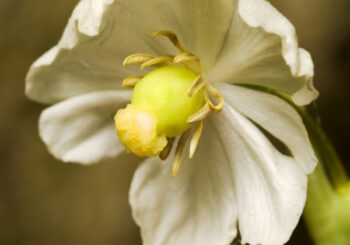Guest Writer for Wake Up World
Mayapple is not a very well-known plant in the West, and those who do know of it may associate it with its poisonous properties. However, for centuries, native cultures have been using mayapple in various forms for its healing effects. What’s more, forward-thinking researchers at Stanford University and elsewhere have discovered substances in this otherwise noxious species which contain promising anti-cancer properties.
[pro_ad_display_adzone id=”110028″]
What is Mayapple?
Mayapple grows all around the world, which is why it is known by many names. You may have heard people refer to it as mandrake, American mandrake, wild mandrake, ground lemon, Duck’s foot, Gwai-kou, Hog apple, Indian podophyllum, Racoonberry, and vegetable mercury.
The mayapple plant tends to prefer damp, forested areas, and it needs at least partial shade and lots of moisture in order to thrive. Thick forests are where you will typically find it growing wild in North America and Canada. The Asian (or “Indian”) variety of mayapple called Podophyllum hexandrum grows naturally in the low-lying areas of the Himalayan mountains in countries such as China (S.W.), India, Pakistan, Afghanistan, Nepal, and Bhutan. In the United States, you may also see mayapple plants being used in ornamental displays and in landscaping, especially on the East Coast. Mayapples have lush, deep green, attractive leaves, bright white, red or yellow flowers, and colorful fruit.
Speaking of the fruit, the common name for this interesting plant can be misleading. The fruit of the mayapple actually does not become harvestable in May (or anytime in the spring for that matter). It is the flower that will begin to appear during this month, while the “apple” does not reach maturity until fall.
Warning: Poisonous Plant Ahead!
It should be noted at this point that most of the mayapple plant is considered poisonous. This includes the roots, leaves, flowers, seeds, and fruit (for most of the year). Unripened green fruit is very toxic. Once the mayapple fruit ripens and turns yellow, however, it is edible, but only in small amounts. Some people use the fruit to make jelly. Even in this form, however, if you consume too much, it may do more harm than good.
If any of this nightshade plant is consumed in tiny amounts (except for ripened fruits), it may result in hallucination. If eaten in excess, mandrake leaves, roots, flowers, seeds, and unripened fruit can be deadly, according to most gardening experts.
It may seem odd that we’re focusing an entire article on a plant that is so poisonous. Keep reading, however, and you will see why mayapple holds a special place in both natural and conventional medicine when processed properly and taken in the right amounts.
Mayapple in Antiquity
With all the above warnings firmly in place, it is also a fact that cultures all over the world have used mayapple for centuries for both medicinal and religious purposes.
The Asian mayapple variety is known as bantrapushi or Giriparpat in Ayurveda. In the Indian region of Kashmir, it is called Banwangun and has been used as a medicinal there since ancient times. “Indian Podophyllum,” as it is sometimes called, has a long history of use in water-based, tincture form. Most formulas prepared this way utilize the roots since, as we shall see, this is where the highest concentration of potentially healing substances is concentrated.
In Europe, mayapple, or mandrake, use goes back to the ancient Greeks and Romans. For these cultures, as with other cultures, it was considered a “magical” plant, although not always for the good (due in large part to its highly toxic properties).
As we shall see, Native peoples in North America have also used mayapple in a variety of ways throughout the centuries.
Podophyllum: What Is It and How Is It Used?
The main healing substance in mayapple is called Podophyllum, which contains powerful healing constituents such as lignan podophyllotoxin and podophyllin.
Medicinally, these substances are used commonly in Ayurveda as a cathartic and for eye conditions. Indian mayapple root is said to contain the highest amount of podophyllum of any of the varieties.
Europeans have used mandrake throughout the years in various forms for stomach ulcers and other digestive conditions such as colic and constipation, for asthma and hay fever, for pain (especially related to rheumatism), and for certain respiratory diseases. It is also a purgative, so it can be used to induce vomiting in the event of poisoning. Others have used it over the years to increase libido.
Amongst Native Americans, mayapple has been used in the above ways as well as serving as an emetic substance. It has also been known to be an anthelmintic agent. A resin made up of North American mayapple was used by Native peoples and colonists alike as a remedy for snakebite.
As you can see, mayapple has been useful in natural medicine for centuries. It is also used in various ways in modern conventional medicine. In fact, two common conventional drugs, etoposide, and teniposide, are derived from mayapple substances and are included on the World Health Organization’s (WHOs) list of “essential medicines.” It is also common as a main topical ingredient for skin conditions and genital warts. For example, the drug Posalfilin, which is used to treat plantar warts, contains podophyllum from mayapple.
And, of course, new research continues to point towards the benefits of Podophyllum and its derivatives for certain kinds of cancer as well as for its chemoprotective and radioprotective effects.
Mayapple Substances and Cancer: The Stanford Study
Etoposide and teniposide are just two pharmaceutical cancer drugs that are derived from the mandrake plant, and which have played a role in conventional cancer treatment. Etoposide is used for small-cell lung cancer and testicular cancer. Teniposide is used in conventional settings for infant leukemia and brain tumors.
Podophyllum is effective against cancer because, since the 1940s, it has been shown to have a cytostatic effect. This means that it can inhibit or slow the growth of cells, especially cancer cells. Podophyllum is also lipid-soluble, so it is easily and quickly absorbed in the GI tract.
Mayapple research reached a turning point in 2015 when a team at Stanford, led by Assistant Professor of Chemical Engineering Elizabeth Sattley, took on the project of mapping out the genome of the Himalayan mayapple, Podophyllum hexandrum.
The Stanford team discovered a way to transfer this plant’s anticancer properties into another plant that could easily be grown inside laboratories. This is beneficial since it may provide a cancer drug that would be safer on the patient, more stable in terms of access and lower in cost.
When the team members punctured mayapple leaves, they discovered that the plant began creating podophyllotoxin-building proteins. This led them to conclude that podophyllum was created in mayapple over time in response and as a deterrent to predators.
Over time, the Stanford team observed 31 new proteins appear around damaged mayapple tissue. Eventually, they isolated 6 of these proteins, which was enough to produce their own podophyllotoxin that they could then inject into another plant.
“A big promise of synthetic biology is to be able to engineer pathways that occur in nature, but if we don’t know what the proteins are, then we can’t even start on that endeavor,” said Sattely in an interview for Science Daily.
The plant they eventually chose to be a host for the podophyllotoxin anticancer substance was Nicotiana benthamiana, a close cousin of the common tobacco plant. Nicotiana benthamiana is more flexible than mayapple in terms of growing conditions. It is a species that can be easily grown indoors in a laboratory.
“My interests are really identifying new molecules and pathways from plants that are important for human health,” says Sattley. “We can only use what the plant gives us.”
Nature Provides All We Need to Thrive
If you’re a long-time reader, then you already know that we 100% believe in the wonderful healing power of whole foods and natural protocols, especially herbs! Remember that the best medicine you can ever employ is to live a life and eat a diet that is supportive of your own amazing pathogen-fighting immune system and detoxification pathways.
That being said, it is also heartening to know that there are some researchers within the conventional medical model that are doing what they can to utilize natural medicines to create treatments that are safer, more targeted, and more effective.
If you are considering utilizing mayapple, i.e., mandrake, for your health in any capacity, be sure to do so under the guidance of a qualified naturopathic doctor (ND) or an integrative or functional medicine doctor. You can buy mayapple root in bulk online and elsewhere, and many people obtain it in this way for skin conditions and other purposes. However, I recommend consulting with a professional even if you are going to use it topically, given the overall toxicity of the plant in general.
Take care of yourself these days and know the Lord has provided all that you need for life and health through the many gifts He has sprinkled throughout Creation. You really do have a choice to work with your Creator and His many gifts, including your own body in living your best and most vibrant life possible!
Originally published at The Truth About Cancer and reproduced here with permission.
About the Author:
Charlene Bollinger is a devoted Christian, happily married wife, joyful mother of 4 beautiful home-educated children, health freedom advocate, and co-founder and CEO of The Truth About Cancer. She is a former model and actress, fitness buff, and lover of healthy food and living. After losing several family members to conventional cancer treatments, Charlene and Ty learned the truth about cancer and the cancer industry, working together tirelessly to help others to learn the truth that sets them free to live healthy, happy lives. Charlene speaks at many conferences and is a guest on various health-related radio shows helping people discover that cancer does NOT have to be a death sentence. Together, they host a biweekly internet news program: TTAC Global Health News.
For more information, visit:
[pro_ad_display_adzone id=”110027″]







